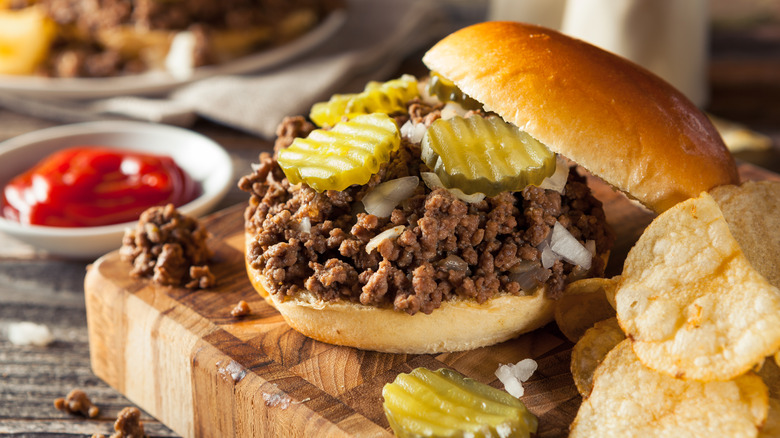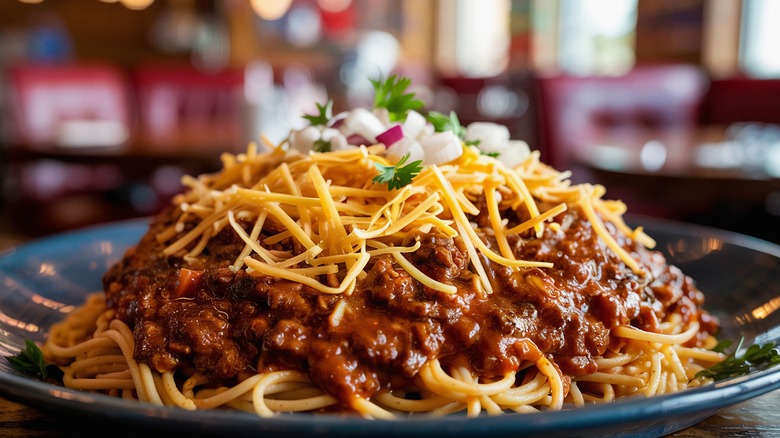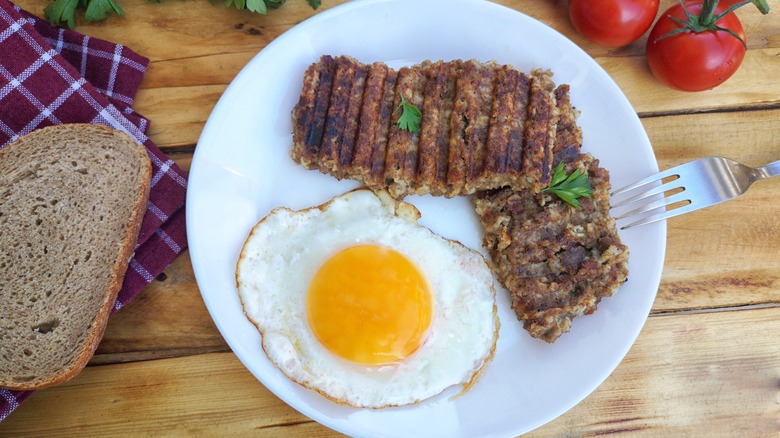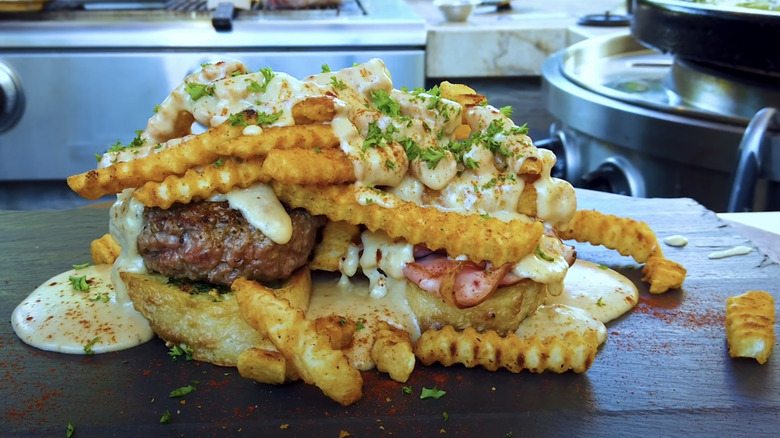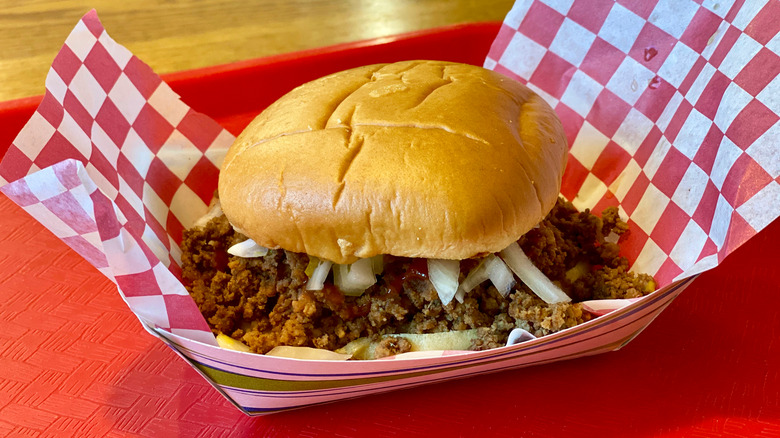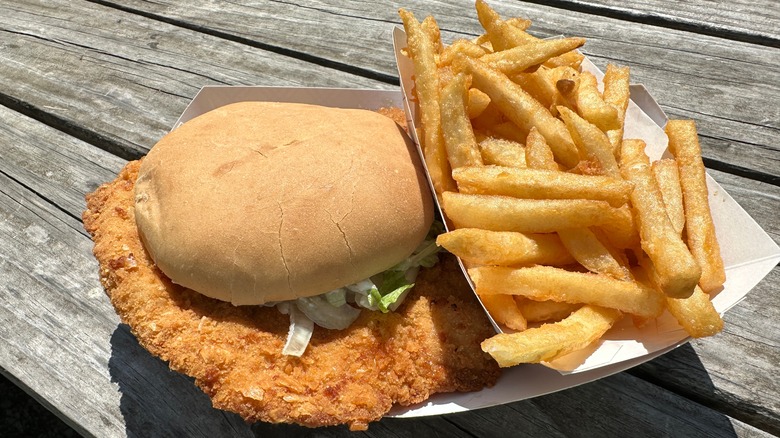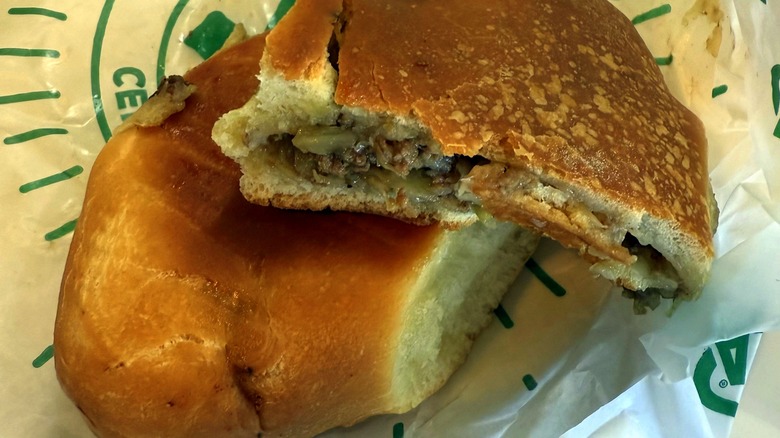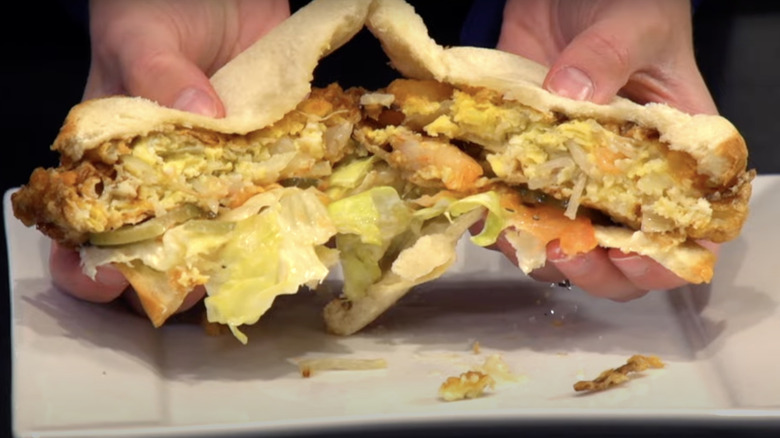10 Old-School Midwestern Foods That Should Be Known Nationwide
Every region of the United States has its own unique flair when it comes to cuisine, and the Midwest certainly has more than its fair share of old-school foods worthy of tables from coast to coast. Each bears with it a story — or legend — of how it came to be a staple on kitchen tables, at church potlucks, at festivals, and even at college stadiums. Some even trace their roots across the Atlantic Ocean as immigrants have peppered in their own heritage to the great melting pot of America.
Since some dispute which states land in which regions, reference has been made to the U.S. Census Bureau as it denotes the Midwest as comprised of Illinois, Indiana, Iowa, Kansas, Michigan, Minnesota, Missouri, Nebraska, North Dakota, Ohio, South Dakota, and Wisconsin. Across those 12 states, wildly popular dishes like pork tenderloin sandwiches, loose meat sandwiches, and runza are often as commonplace as burgers and killer chicken wings — and they may be worth adding to menus nationwide.
Cincinnati chili
While mention of chili may conjure up thoughts of cold nights and campfires for most, those in Ohio's Queen City likely think fondly of cozy parlors and spaghetti. That's because Cincinnati's early 20th century spin on the popular dish was worthy enough to credit it with a unique title unto itself. Cincinnati chili is just one of many different styles of chili to know, make and share. The true origin of Cincinnati chili, though, is under dispute. Some contend that Greek immigrant Emmanuel Karam's Chili House was responsible for fusing the hearty Texan concoction with more exotic spices like cinnamon, chocolate, and allspice. Others consider Macedonian brothers Tom and John Kiradjieff who'd opened their own Greek restaurant, Empress Chili Parlor, the same year and similarly added Middle Eastern flavors.
No matter who is truly responsible for the dish's creation, the decades that followed saw scores of chili parlors — so called because of their limited offerings akin to ice cream parlors — crop up across the city and throughout the Buckeye State. Should the opportunity arise to visit such an establishment, be prepared to order your Cincinnati chili two-, three-, four-, or five-way. After the basic chili with spaghetti, the next level includes shredded cheddar cheese topping while the latter two build upon that, first with either beans or onions, and then with both.
Goetta
Unique chili isn't the only Midwestern food popularized in Cincinnati. Goetta is served up daily at breakfast time across the Queen City. As the county seat of Hamilton County, Cincinnati has had its share of immigration waves, including an influx of Germans throughout the 19th century. As such, recipes were hauled overseas with them, but traditional ingredients haven't always been so readily available. Lacking buckwheat, the new crop of Americans improvised and substituted oats to scratch together the stateside equivalent of their grilled sausage patties known as Goetta.
Combining the Old World blend of herbs and spices with beef, pork, and steel-cut oats in place of buckwheat, the grain sausage simmers together before being formed into a patty and fried. Despite the food's popularity in Cincinnati, some believe that the breakfast staple may have first cropped up on the other side of the Ohio River in Covington, Kentucky. In fact, that's where Goetta producer Glier's Meats continues to host an annual Goettafest on the riverfront as games and music accompany more than 50 menu items featuring Goetta.
Gooey butter cake
The Show-me State lays claim to several old-school foods deserving of broader reach, not least of which is gooey butter cake. This dessert's widely accepted — though hardly definitive — origin is regularly credited to a German baker in 1940s St. Louis who had faltered in his attempt to craft another popular old-timey dessert: coffee cake. With baking being more culinary science than culinary art, incorrect measurements can translate to failures or — as famed artist Bob Ross so often said — happy accidents.
Whether an errant mix-up of the flour to sugar ratio, the addition of too much of some combination of butter, shortening, or sugar, a mishap regarding glycerin and leavening proportions, or an on-the-fly improvisation substituting granulated sugar with powdered sugar, the resulting confection was hardly coffee cake — but it was also too good to discard under the constraints of the Great Depression. Whichever story holds true, fanfare for the crunchy exterior and gooey, pudding-like interior of this cake spread throughout the Midwest and these days can find a home with the popular treats of any other region.
Horseshoe sandwich
In 1920s Springfield, Illinois, a sandwich was born that defies traditional norms in an open-face style, piling ingredients high with some farrier-inspired nomenclature. Its name is drawn from the shape of the piece of ham that was originally placed on the sandwich. Chef Joe Schweska is credited with crafting the first horseshoe sandwich at the Leland Hotel. However, the inspiration is said to have come from his wife, Elizabeth, who'd suggested utilizing Welsh rarebit sauce for an open-face design.
From there, Schweska assembled his sandwich, topping slices of toasted bread with ham cut from the bone before adding a heaping helping of french fries — considered the nails to the horseshoe. After that, the cheese sauce is poured on the entire dish, and it's served on a sizzling platter dubbed the anvil. In the decades since its creation, the horseshoe sandwich has expanded its appeal to other palates, substituting hamburgers, poultry, pulled pork, and — in some cases — even vegetables in place of the ham.
Loose meat sandwich (aka Maid-Rite sandwich)
Somewhere on the sandwich spectrum between burger and sloppy Joe, you'll find this Iowa staple: the loose meat sandwich. Pairing seasoned ground beef with pickle slices, diced onion, and mustard, this Hawkeye specialty has been served up on a toasted bun since the 1920s. Like many old-school Midwestern foods, the loose meat sandwich has its origin in dispute. Some point to its start with Fred Angell's then-fledgling franchise in 1926 in Muscatine, Iowa: Maid-Rite.
Treated by many as synonymous with loose meat, Maid-Rite ended up selling franchising rights to Cliff Taylor who would open Taylor's Maid-Rite Hamburger Shop in 1928. Since then, the family business featuring loose meat sandwiches has expanded across the Midwest to 14 locations in Iowa, five in Illinois, two in Minnesota, three in Missouri, and one in Ohio. Still, some argue that Angell's creation came two years after separate establishments in Sioux City, Iowa, already had the crumbled beef sandwich available to order. Despite its regional existence, the loose meat sandwich has occasionally cropped up at the national level, including a presence on the hit sitcom "Roseanne" at the Lanford Lunch Box (which scored an honorable mention on the list of best fictional restaurants) and an appearance on the drama "The Good Wife."
Pork tenderloin sandwich
It may look like it should be part of a competitive eating challenge, but fans recognize the size of the pork tenderloin sandwich — often hanging over the bun at double the size — as part of the charm. The unofficial sandwich of Indiana features a pork cutlet, pounded down sometimes as big as the plate it is served on, that is then breaded and fried before getting adorned with condiments such as ketchup, mayonnaise, onions, and other toppings, just like a burger.
Hoosiers aren't alone in savoring the behemoth on a bun — often celebrated with Tenderloin Tuesdays throughout July — as Iowans also indulge in the breaded pork sandwich. Just as there is no agreement on who serves up the best iteration of the platter-sized pork, with each state producing its fair share of tasting trails to build road trips around, there is also no consensus on how to tackle the handheld monster. While some prefer to cut off the excess meat to enjoy separately or to cleave the cutlet in two to double stack their sandwich, others simply throw caution to the wind and have at it with this regional fare that could fit in at any restaurant alongside burgers and chicken sandwiches.
Runza
Nearly two centuries after Catherine the Great deposed her husband and invited Germans to bring their culture to farmlands along Russia's Volga River, another relocation found many towing their Old World traditions to the Midwest. This included bringing their riff on the pocket sandwich to Nebraska, setting the stage for cornhuskers to fall in love with runza. Akin to pierogi and bierock, the runza is composed of yeasted bread dough typically filled with meat, cabbage, and onions. Some varieties also include cheese.
As the communities producing these easy-to-transport sandwiches in their home kitchens grew throughout the early 20th century, one enterprising family saw fit to start delivering runza to the masses. So it was that Sally Everett and her brother Alex Brening opened the first Runza restaurant in Lincoln, Nebraska, in 1949. The restaurant name was trademarked along with the name of the sandwich it served. It would be three decades before franchising opportunities would become available. While the menu expanded to include more fast food fare, so too did the reach of Runza with a partnership forged with the University of Nebraska in 2000. Though only a handful of Runza locations have opened across Colorado, Iowa, and Kansas, the university's Memorial Stadium, holding roughly 85,000 spectators, often sells runza by the thousands on game day.
St. Paul sandwich
Unlike what its name may suggest, the St. Paul sandwich's only connection to Minnesota's Twin Cities is believed to be an homage by the man often credited with its creation. Many hold that St. Paul native Steven Yuen crafted this egg-foo-young-starring handheld in St. Louis, Missouri, as a menu item in the 1940s at his restaurant, Park Chop Suey. Though some scholars have traced evidence of the sandwich's creation back some decades earlier in the Land of 10,000 Lakes, it remains that the old-school food is a favorite in the Gateway to the West.
Like the contemporary Massachusetts chow mein sandwich — which fries the eponymous noodles before covering them in gravy and serving them on a bun — the St. Paul sandwich fuses Chinese and American cuisine. Built upon two slices of white bread, it's the diner's preference as to what meat the egg foo young patty — basically a fried omelette — gets filled with before it is topped with lettuce, mayonnaise, pickles, and tomato and served between two pieces of bread.
Tater Tot Hotdish
Thanks to the Grace Lutheran Ladies Aid of Mankato, Minnesota, the Midwest has what is considered to be the first recorded recipe of a hotdish out of their Great Depression era community cookbook. Two decades later, with the help of Ore-Ida founders F. Nephi Grigg and Golden Grigg, this casserole took on a whole new dimension following the invention of tater tots. The dish was already one meant to stretch ingredients while satisfying the need for a hearty meal with hamburger meat, a box of pasta, and a combination of canned and fresh vegetables.
As the hotdish was handed off to the next generation, scarcity found an upgrade to comfort, and recipes began cropping up retrofitting the casserole with the convenience of the tater tot, readily used to create a satisfyingly crunchy and golden-brown top layer when baked. Since its inception, many have added their own twist onto the old-school cuisine that remains a staple in Midwest states like Minnesota, North Dakota, and South Dakota, like this truffle oil-drizzled upscale tater tot casserole.
Trenary toast
In another example of Old World traditions translated into old-school Midwest foods worthy of spreading beyond their regional popularity, Scandinavian immigrants are to be thanked for the origin of Trenary toast. The twice baked bread, or rusk, that's coated with cinnamon-sugar is known as korppu in Finland. Several decades after a sizable Finnish community had cropped up in Michigan's Upper Peninsula, Elise and Jorma Syrannen established their own bakery to begin spreading the toast outside the unincorporated community of Alger County known as Trenary.
Dubbed the Trenary Home Bakery, the couple's business expanded its reach well beyond the breakfast tables of Yoopers looking for a satisfying crunch with their morning coffee or a vehicle to carry their jam. In fact, locations across much of the upper Midwest carry Trenary's little brown bags in flavors beyond the original, such as: Scandinavian staple Indian cardamom, chocolate chip, and tart cherry. The bakery's reach has even brought the Scandinavian treat to the Pacific Northwest with products available in Seattle and Portland.

